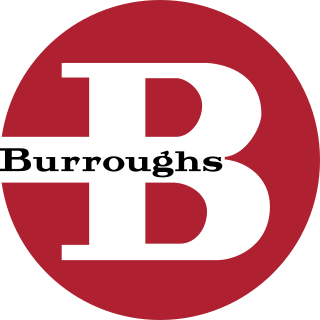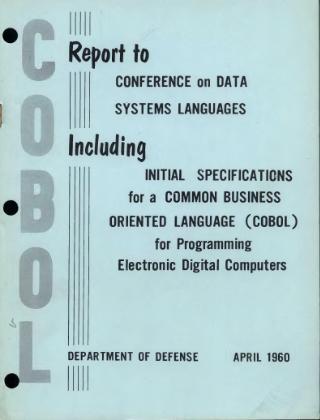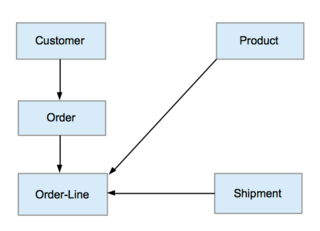Related Research Articles

The Burroughs Corporation was a major American manufacturer of business equipment. The company was founded in 1886 as the American Arithmometer Company by William Seward Burroughs. In 1986, it merged with Sperry UNIVAC to form Unisys. The company's history paralleled many of the major developments in computing. At its start, it produced mechanical adding machines, and later moved into programmable ledgers and then computers. It was one of the largest producers of mainframe computers in the world, also producing related equipment including typewriters and printers.

COBOL is a compiled English-like computer programming language designed for business use. It is an imperative, procedural, and, since 2002, object-oriented language. COBOL is primarily used in business, finance, and administrative systems for companies and governments. COBOL is still widely used in applications deployed on mainframe computers, such as large-scale batch and transaction processing jobs. Many large financial institutions were developing new systems in the language as late as 2006, but most programming in COBOL today is purely to maintain existing applications. Programs are being moved to new platforms, rewritten in modern languages, or replaced with other software.

In computing, a database is an organized collection of data or a type of data store based on the use of a database management system (DBMS), the software that interacts with end users, applications, and the database itself to capture and analyze the data. The DBMS additionally encompasses the core facilities provided to administer the database. The sum total of the database, the DBMS and the associated applications can be referred to as a database system. Often the term "database" is also used loosely to refer to any of the DBMS, the database system or an application associated with the database.

Grace Brewster Hopper was an American computer scientist, mathematician, and United States Navy rear admiral. She was a pioneer of computer programming. Hopper was the first to devise the theory of machine-independent programming languages, and used this theory to develop the FLOW-MATIC programming language and COBOL, an early high-level programming language still in use today. She was also one of the first programmers on the Harvard Mark I computer. She is credited with writing the first computer manual, "A Manual of Operation for the Automatic Sequence Controlled Calculator."
Information retrieval (IR) in computing and information science is the task of identifying and retrieving information system resources that are relevant to an information need. The information need can be specified in the form of a search query. In the case of document retrieval, queries can be based on full-text or other content-based indexing. Information retrieval is the science of searching for information in a document, searching for documents themselves, and also searching for the metadata that describes data, and for databases of texts, images or sounds.
PL/I is a procedural, imperative computer programming language initially developed by IBM. It is designed for scientific, engineering, business and system programming. It has been in continuous use by academic, commercial and industrial organizations since it was introduced in the 1960s.

In computing, the network model is a database model conceived as a flexible way of representing objects and their relationships. Its distinguishing feature is that the schema, viewed as a graph in which object types are nodes and relationship types are arcs, is not restricted to being a hierarchy or lattice.
CODASYL, the Conference/Committee on Data Systems Languages, was a consortium formed in 1959 to guide the development of a standard programming language that could be used on many computers. This effort led to the development of the programming language COBOL, the CODASYL Data Model, and other technical standards.
The Burroughs Large Systems Group produced a family of large 48-bit mainframes using stack machine instruction sets with dense syllables. The first machine in the family was the B5000 in 1961, which was optimized for compiling ALGOL 60 programs extremely well, using single-pass compilers. The B5000 evolved into the B5500 and the B5700. Subsequent major redesigns include the B6500/B6700 line and its successors, as well as the separate B8500 line.
Electronic data processing (EDP) or business information processing can refer to the use of automated methods to process commercial data. Typically, this uses relatively simple, repetitive activities to process large volumes of similar information. For example: stock updates applied to an inventory, banking transactions applied to account and customer master files, booking and ticketing transactions to an airline's reservation system, billing for utility services. The modifier "electronic" or "automatic" was used with "data processing" (DP), especially c. 1960, to distinguish human clerical data processing from that done by computer.
RPG is a high-level programming language for business applications, introduced in 1959 for the IBM 1401. It is most well known as the primary programming language of IBM's midrange computer product line, including the IBM i operating system. RPG has traditionally featured a number of distinctive concepts, such as the program cycle, and the column-oriented syntax. The most recent version is RPG IV, which includes a number of modernization features, including free-form syntax.
A database server is a server which uses a database application that provides database services to other computer programs or to computers, as defined by the client–server model. Database management systems (DBMSs) frequently provide database-server functionality, and some database management systems rely exclusively on the client–server model for database access.

The history of programming languages spans from documentation of early mechanical computers to modern tools for software development. Early programming languages were highly specialized, relying on mathematical notation and similarly obscure syntax. Throughout the 20th century, research in compiler theory led to the creation of high-level programming languages, which use a more accessible syntax to communicate instructions.
The Burroughs B2500 through Burroughs B4900 was a series of mainframe computers developed and manufactured by Burroughs Corporation in Pasadena, California, United States, from 1966 to 1991. They were aimed at the business world with an instruction set optimized for the COBOL programming language. They were also known as Burroughs Medium Systems, by contrast with the Burroughs Large Systems and Burroughs Small Systems.
LINC is a fourth-generation programming language, used mostly on Unisys computer systems.
The Formatted File System (FFS) is the name of a series of Database Management Systems (DBMS) developed for military use and designed to run on IBM mainframe computers.
T. William (Bill) Olle was a British computer scientist and consultant and President of T. William Olle Associates, England.
Many programming languages and other computer files have a directive, often called include, import, or copy, that causes the contents of the specified file to be inserted into the original file. These included files are called header files or copybooks. They are often used to define the physical layout of program data, pieces of procedural code, and/or forward declarations while promoting encapsulation and the reuse of code or data.
The Universal Time-Sharing System (UTS) is a discontinued operating system for the XDS Sigma series of computers, succeeding Batch Processing Monitor (BPM)/Batch Time-Sharing Monitor (BTM). UTS was announced in 1966, but because of delays did not actually ship until 1971. It was designed to provide multi-programming services for online (interactive) user programs in addition to batch-mode production jobs, symbiont (spooled) I/O, and critical real-time processes. System daemons, called "ghost jobs" were used to run monitor code in user space. The final release, D00, shipped in January, 1973. It was succeeded by the CP-V operating system, which combined UTS with features of the heavily batch-oriented Xerox Operating System (XOS).
Albert Eugene Smith (1907–1973) was a computing pioneer who worked for the U.S. Navy following World War II. He founded the Digital Computer Newsletter published by the Navy from 1949 through 1968. Smith also participated in the development of the COBOL programming language.
References
- ↑ "Burroughs' Future in Electronics - NMAA Address by Mary Hawes - 1959". www.smecc.org. Retrieved 2016-11-08.
- ↑ "Proposing COBOL". National Museum of American History. 2012-04-04. Retrieved 2020-07-25.
- ↑ Sammet, Jean (1981). History of Programming Languages. Academic Press. pp. 199–243. ISBN 0-12-745040-8.